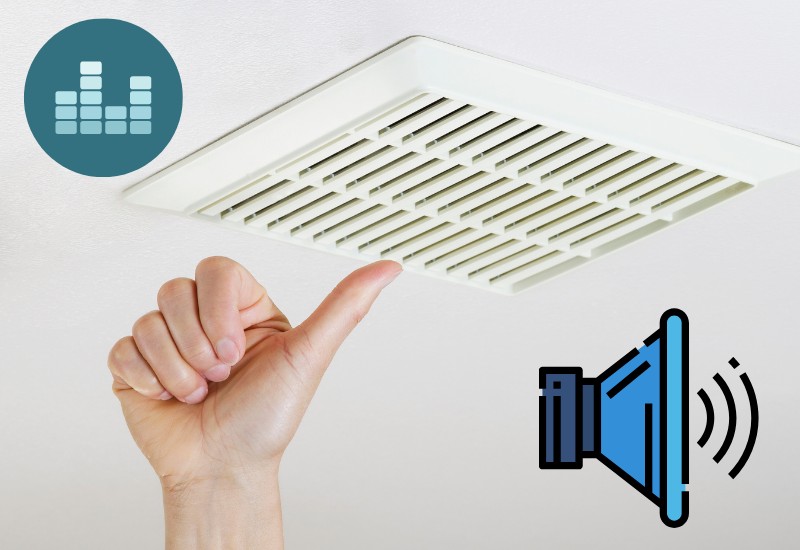When it comes to exhaust fans, is bigger always better? The answer to that question isn’t always black and white. However, in most cases, it’s a good idea to oversize your bathroom exhaust fan.
In this blog post, we will answer some of the most common questions about bathroom exhaust fans. We’ll go over topics related to your exhaust fan CFM, oversizing your existing bathroom fan setup, and even touch on the desired sones rating of your bathroom fan.
So whether you’re just starting to shop for a new exhaust fan or you’re looking to replace an old one, this blog post will provide you with the information you need!
Can My Bathroom Fan Be Too Big?

Yes, your bathroom fan can be too big. A bathroom exhaust fan that is much too large for the area will only increase your energy bill, fill your space with cold air in the winters, and ultimately, not perform its job effectively.
In this case, bigger is not always better.
When it comes to exhaust fans, you want one that is just the right size for your bathroom space.
How Many CFM Should My Bathroom Fan Be?
According to the National Electrical Code (NEC), when it comes to residential buildings, the minimum requirement for bathroom CFM is 50 CFM.

A CFM is a unit of measurement that denotes the amount of air moving through a space in one minute. This means that for bathrooms that are 100 square feet or less, you will need an exhaust fan that can move at least 50 CFM of air per minute. In actuality though, 50 CFM is rarely enough.
For instance, if you have even an average master bathroom (larger than a powder room) you’ll most likely want a bathroom fan with more power than 50 CFM simply to keep up with the supply of fresh ventilation.
When working with a much larger space, say over 100 square feet, exhaust fan sizes will greatly increase. Not just due to the square footage, but also the type of bathroom fixtures you have. This matters because a fixture like a bathtub with jets can produce way more heat and moisture than a standard sink, for example.
Are All Bathroom Fans the Same Size?

No, all bathroom exhaust fans are not the same size. In fact, they come in a wide range of shapes and sizes to fit all sorts of different needs.
When choosing the right exhaust fan for your bathroom, you’ll want to take several factors into consideration such as:
- The size of the bathroom
- The type of fixtures you have
- The size of your air duct
Can I Oversize My Bathroom Fan?
Yes, you can oversize your bathroom exhaust fan. In fact, in most cases, it’s a good idea to do so!

Remember how we talked about the minimum CFM requirement being 50 CFM? Well, even though that may be the code requirements, you’ll likely want a bathroom exhaust fan with more power than that.
How much more power?
Well, that depends on the size of your bathroom and the type of fixtures you have.
For example, if you have a small bathroom with only a shower, you may be able to get away with an exhaust fan that is 60-80 CFM. But if you have a large bathroom with a tub, shower, and multiple sinks, you may want an exhaust fan that is closer to 100 CFM or more.
As a general rule of thumb, it’s always a good idea to oversize your bathroom exhaust fan. This way you can be sure that your exhaust fan will be powerful enough to do its job without being so powerful that it’s overkill.
Is Higher CFM Better for Bathroom Fan?
Yes, a higher CFM is better for a bathroom fan, but only within limits. If your bathroom area calls for 60 CFM, an 80 CFM fan would be better to use and even acceptable by most standards.

But if that same space calling for 60 CFM is then replaced with a fan with a 90 CFM rating, you might be pushing your luck. Not only will this exhaust fan be drawing more energy than necessary, but the extra CFM might cause other issues like drafts or the inability to dry up the moisture still hanging around in the bathroom.
And we all know what extended exposure to moisture can do to a bathroom!
In short, higher CFM is better for bathroom fans, as long as it is within an acceptable range.
How Do I Calculate CFM for Bathroom Exhaust?
The easiest way to calculate CFM for your bathroom exhaust is to determine what the square footage of your bathroom is.

A single CFM is equivalent to 1 square foot of floor area. So if you have a bathroom that is 75 square feet, you will need a bathroom exhaust fan that can move at least 75 CFM of air per minute. Again, you usually want to oversize your fan just to be sure it’s enough for the job.
If we go with this example of 75 square feet, it would be acceptable to size up your bathroom fan to an exhaust fan that is 80 to 90 CFM.
If you don’t know how to calculate the square feet of your bathroom, don’t worry! We’ve got you covered with a quick and easy method.
To calculate the square footage of your bathroom, simply measure the length and width of your bathroom in feet. Once you have those numbers, multiply them together to get the square footage.
For example:
If your bathroom is 12 feet long and 8 feet wide, your square footage would be 96 sq. ft., which equals a CFM of 96.
Do I Need an Exhaust Fan in My Bathroom?

This is a common question, and the answer is not as simple as a yes or no.
The main purpose of an exhaust fan is to remove odors, moisture, and humid air from your bathroom. This is especially important if you have a bathroom with no windows that can be opened to let in the fresh air.
Building code, along with NEC requires you to have an exhaust fan in your bathroom if the space is without window access. In some areas, a bathroom fan is still required even if a window is available.
However, we always recommend having an exhaust fan in your bathroom regardless of the size. Not only will it help to remove any unwanted odors, but it will also help to keep your bathroom feeling fresh and comfortable.
How Many Sones Is a Quiet Bathroom Fan?

A sone is a unit of measurement that is used to describe the loudness of a sound. The lower the sone rating, the quieter the sound.
Sones are measured in halves, like 1.5, 2, 2.5, etc., until the loudness of the sound reaches levels so low, that measurements are taken in 0.1 increments.
According to Broan NuTone product manager, Pete Schrader:
Typical bath fans range anywhere from <0.3 sones to 6.0 sones.
The low end of that range is a high-functioning bath fan that you wouldn’t know is running if you hadn’t turned it on. To give you some perspective, a sone level of 3.0 is the same level of noise you would hear between two coworkers having a conversation face-to-face.
If you’re interested in having a quiet bathroom fan, your bathroom fan should have a sone level of 1.0 or less. Anything more than that and you are talking about noises that are similar to public spaces.
You should be aware that the lower the sones, the lower the CFM of your exhaust fan is. So take that into consideration and ask yourself how quiet do you really need your bathroom fan?
Conclusion

Exhaust fans are an important addition to any bathroom, as they help remove odors, moisture, and humid air. While building code requires exhaust fans in some bathrooms, we always recommend having one for the sake of comfort and freshness.
In this blog post, we have answered some common questions about bathroom exhaust fans – like how many CFM you need and how many sones is a quiet bathroom fan.
We hope you found this post helpful and that it has answered any questions you may have had about exhaust fans! If not, please reach out to us so we can help in any way we can.
And, if you’re not in a rush, be sure to check out our post on small bathroom remodel ideas. Why stop at replacing your fan?




1 Comments
Comments are closed.